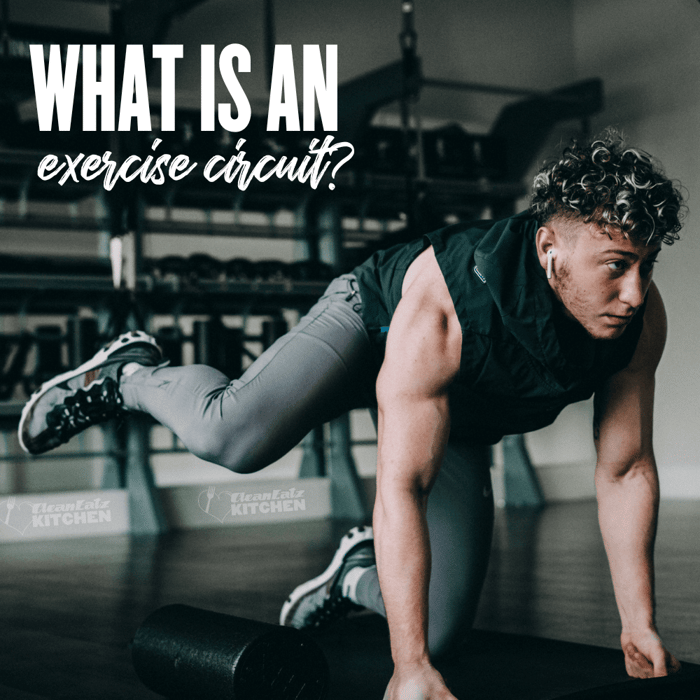
What is Circuit Training?
Jason Nista
Exercises & Fitness
9 minute read
If you're looking to maximize your time at the gym, or you're just looking for a new way to challenge your body, then circuit training is ideal for you. But what is circuit training?
Circuit training is a great way to get in a full-body workout in a short amount of time. Moreover, it's versatile—you can pretty much do any type of exercise in a circuit.
In this guide, we'll break down the basics of how to do an exercise circuit the right way to ensure optimum results with minimum effort.
What Is an Exercise Circuit?
The exercise circuit is one of the most effective ways to get fit, but it can also be difficult to set up and use. If you're not sure how to do an exercise circuit or what equipment you need for one, this article will give you all the information that you need.
An exercise circuit is a series of exercises that are done one after the other, with no rest in between.
What is an exercise circuit? Well, instead of taking a break between each exercise or group of exercises, you simply go from one exercise to the next.
Circuits are also called "supersets."
This refers to the fact that instead of completing all three sets of an exercise before moving on to another exercise, you move directly from one set to another set while only resting briefly at the end of every superset.
They may also be called supersets because the results you get from them will make you look like a superhero!
The exercises involved in a circuit can be aerobic or strength training exercises.
The length of time required for each circuit will vary, but many circuits last from 30 seconds to 2-3 minutes at most.
When done correctly, circuits can be more effective than regular cardio workout routines because they recruit multiple large muscle groups at once and allow you to burn calories faster.
In addition, strength training exercises provide more benefits than cardiovascular activity alone by strengthening bones, improving balance and coordination, increasing metabolism and improving posture.
Here are some examples of aerobic (cardiovascular) exercises:
- running (jogging/sprinting)
- cycling (stationary bike)
- swimming
- rowing machine
Here are some examples of strength training exercises:
- pushups
- pull ups/chin ups
- squats
- lunges
When doing a strength training circuit, usually each exercise requires only one set to complete the exercise.
Sets are defined as the number of repetitions (reps) and/or time taken to complete an exercise.
How many sets you should do depends on your fitness level and how long you plan on working out for. The goal is not to be able to lift heavy weights, but rather focus on using proper form with lighter weights in order to build up muscle endurance and shape your body over time.
Each exercise should be completed slowly and correctly, with constant tension on the muscles throughout the movement.
Once you're done with each exercise, it's important to rest and recover. This allows your muscles to rebuild themselves and get stronger so they can better handle the demands of future workouts.
If you want to know what is an exercise circuit you can do at home, try picking a few exercises from this list that work well together:
- Side lunges with arm curl
- Squat to overhead extension
- Forward lunge with tricep kickback
- Plie squat with front arm raises
In a circuit, you complete the exercises in an order that makes sense for your workout goals.
How you order your exercise circuit is important. It depends on your goals and fitness level, as well as the equipment that's available to you.
For example, if you don’t have access to weights or kettlebells, it would make sense for you to start with bodyweight exercises.
Or maybe you're someone who can already do several sets of push-ups and pull-ups but wants to challenge themselves further; in this case, a circuit that begins with squats and ends with wall sits would be more suitable for your needs.
If none of these options seem like what will work best for your personal routine, don't worry!
There are plenty more ways to design circuits—it just takes some creativity (and maybe some trial-and-error).
Benefits of Using Exercise Circuits
You already know what is circuit training, but what benefits does it have? Circuit training is a great way to get fit. You can achieve maximum results in minimum time, and it's a great option if you're short on gym time.
But, like everything else, there are right and wrong ways to do it. Follow our step-by-step guide, and you'll be well on your way to getting fit with circuits.
Circuit training is all about efficiency. You're working multiple muscle groups at once, so you're getting more done in less time. This also means that you're burning more calories, and you're likely to see results sooner than you would with traditional weight-training methods.
How to Create an Effective Exercise Circuit
Now that you know what an exercise circuit is, it's time to put one together. Follow these steps to produce the ideal exercise circuit for yourself:
- Choose the exercises you want to do.
- Create a circuit that includes each of those exercises.
- Alternate between the exercises, doing each one for the prescribed number of repetitions or times.
- Rest when you need to, but try to keep your rest periods short so you can keep moving.
- Repeat until you've completed all the repetitions or reached the time limit.
It's as simple as that! Just remember to choose exercises that target all of the major muscle groups, and to mix them up often to keep your body guessing and getting the most out of your circuit training.
Tips for Getting the Most Out of Your Circuit Workout
Now that you know what an exercise circuit is and how to put one together, here are a few additional tips for getting the most out of your circuit workout.
First and foremost, warm up with some dynamic stretching, such as arm circles and bodyweight squats. This will help prepare your muscles for the workout to come.
Second, don’t be afraid to challenge yourself. Sure, you can start off with lighter weights and shorter durations, but push yourself to increase your intensity over time. It's only when we push our limits that we can really make fitness progress.
Third, focus on form and technique rather than speed or heavy load. Keep track of each rep and rest period and make sure you stay in control throughout the entire exercise. Also, make sure you’re breathing at an appropriate rate. This will help keep you energized throughout the entire circuit workout session.
Last but not least—have fun! Keep your motivation high by creating an enjoyable atmosphere as you work out. Playing some upbeat music or incorporating some team challenges into your session can help add an extra layer of positivity to your exercise routine.
What Are Some Common Exercises Used in Exercise Circuits?
When it comes to figuring out what exercises to use in your exercise circuit, you’ll want to make sure that you pick exercises that you can complete quickly and efficiently. Common exercises used in exercise circuits consist of bodyweight exercises like push-ups, squats, burpees, and mountain climbers. Depending on your skill level, you can also work kettlebell or barbell movements into your circuit.
The key is to identify exercises that hit the most muscle groups at once—these will give you the most bang for your buck! Compound exercises like squats and push-ups or squats and shrugs are great options because they combine two movements with one exercise. Whatever combination of movements you go with, just be sure to focus on proper form throughout the entire duration of the set.
So, there you have it! You now know everything you need to know about how to do an exercise circuit. Just make sure you pace yourself, don’t overdo it, and drink plenty of water, and you're sure to see results in no time!
If you want to produce better results sooner, then you need to follow a suitable diet plan. A diet plan ensures that your body gets access to all the essential nutrients that it needs to grow stronger. Clean Eatz Kitchen brings you a huge variety of meal plans with the right mix of taste and nutrition to keep you motivated to exercise regularly.
Final Thoughts
An exercise circuit is a series of exercises done one after another without any rest in between. Circuit training allows you to produce better results in less time. To create the ideal exercise circuit, you need to include exercises that target the muscle group that you want to train. To make your circuit training more effective, warm up beforehand, challenge yourself, and ensure the right form and technique. A combination of bodyweight exercises and compound exercises will help you get the most results out of an exercise circuit.
FAQ
How long should a typical circuit training session last?
The duration of a circuit training session can vary based on your fitness goals and available time. A typical session may last anywhere from 20 to 45 minutes. Shorter workouts with higher intensity can be effective for time-conscious individuals, while longer sessions can provide a more comprehensive workout.
What equipment do I need for circuit training?
Circuit training can be done with minimal equipment, such as dumbbells, resistance bands, or bodyweight exercises. You can also incorporate gym machines or specialized equipment if available. The key is to choose exercises that align with your goals and equipment accessibility.
Is circuit training suitable for weight loss?
Yes, circuit training is an excellent choice for weight loss. It elevates your heart rate and burns calories efficiently while building lean muscle mass. Additionally, the afterburn effect (excess post-exercise oxygen consumption) can help you continue burning calories even after your workout.
How often should I do circuit training workouts?
The frequency of circuit training workouts depends on your fitness goals and recovery time. Beginners may start with 2-3 sessions per week, while those with more experience can aim for 3-5 sessions. Allow at least 48 hours of rest between intense circuit training sessions to give your muscles time to recover.
Related Articles
What Effect Does Exercise Have on The Nervous System?
5 minute read
The Benefits of High-Intensity Interval Training (HIIT)
6 minute read
How Many Calories Should I Burn a Day Exercising?
11 minute read



